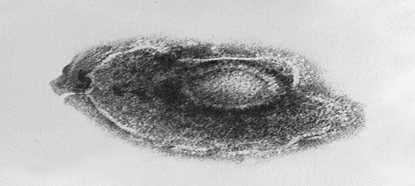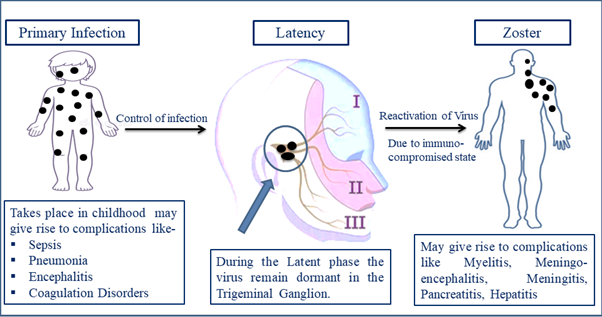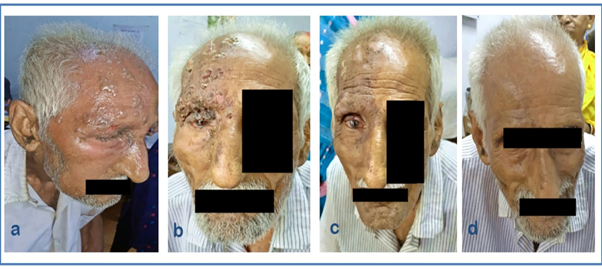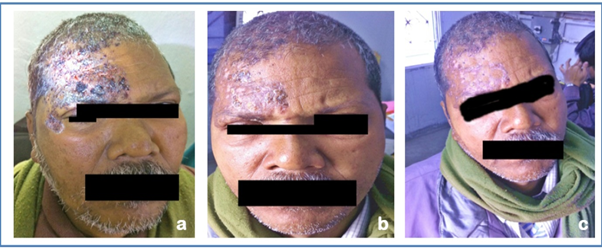International Journal of
eISSN: 2381-1803


Case Report Volume 18 Issue 1
1Professor and Head, Department of Practice of Medicine, Mahesh Bhattacharyya Homoeopathic Medical College and Hospital, West Bengal, India
2Assistant Professor Department of Physiology, N.C.C. Homeopathic Medical College and Hospital, West Bengal, India
3Post Graduate Trainee, Mahesh Bhattacharyya Homoeopathic Medical College and Hospital, West Bengal, India
4Assistant Professor, Department of Repertory, Kharagpur Homoeopathic Medical College and Hospital, West Bengal, India
Correspondence:
Received: December 22, 2024 | Published: January 7, 2025
Citation: Choudhury S, Bhattacharya S, Ghosh S, et al. Herpes zoster facialis managed with homeopathic intervention, a narrative case-report of two cases. Int J Complement Alt Med. 2025;18(1):1-4. DOI: 10.15406/ijcam.2025.18.00717
Herpes zoster (HZ) is a debilitating viral infection causing a dermatomal vesicular rash. Many known risk factors exist in India and adults >50 years of age may be especially susceptible to HZ. However, HZ is not a notifiable disease in India and data on incidence and disease burden is lacking. Homeopathy has a long history of showing a significant impact in controlling viral diseases which we have seen during the Covid-19 pandemic as well. In this case report we intend to report two cases of herpes zoster out-break in elderly male patients. Symptoms of vesicular eruption, burning, and tachycardia with increased body temperature were evident in both cases with varying intensities. Considering the acuteness of the diseases, both were prescribed Pyrogen 200CH, at an interval of an hour, followed by a placebo. Considering the favourable prognosis and signs of healing over the affected area they were prescribed Calendula officinalis 1000CH in fractional distillation. In both these cases, rapid gentle relief without any adverse events was observed. Hence we raise the possibility of homeopathy having a pivotal role in managing the re-infection of varicella zoster among the elderly population. We also believe that this novel case series harnesses the path for future research among the larger population to understand the scope and limitations regarding the usefulness of these ultra-diluted homeopathic medicines.
Keywords: herpes zoster, re-activation of herpes virus, homeopathy, case-reports
Herpes zoster is a painful, infectious, neuro-cutaneous disease caused by the reactivation of varicella-zoster virus (VZV). The VZV belongs to the alpha herpesvirus family and causes chickenpox (varicella) and herpes zoster (HZ) in human beings (Figure 1).1 To date, human is considered the only known reservoir of the virus where the virus usually remains dormant at the dorsal root ganglion or cranial nerves after the primary infection.2 HZ is due to the reactivation of the virus from its latency due to an age-related decrease in cellular immunity or due to pre-existing disease conditions [e.g.- asthma, coronary heart disease, chronic obstructive pulmonary disease (COPD), diabetes, systemic lupus erythematosus (SLE) and rheumatoid arthritis (RA)], or medical therapies leading to immuno-suppression.2 In the initial stage of infection, the disease is foreshadowed by prodromal symptoms such as pruritus, numbness, tingling, and/or pain in a unilateral dermatomal pattern, which evolves into a painful vesicular rash that lasts a variable amount of time.3 Though it is rarely life-threatening as the mortality is 0.28-0.69 cases per 1 million the acute episode of attack and sequelae of the disease following the acute episode cause significant suffering.1 Secondary to HZ a patient may develop secondary infections, neurological adverse events such as post-herpetic neuralgia (PHN), facial paralysis, stroke, and ophthalmological adverse events such as keratitis and loss of vision.4 In India, HZ is not a notifiable disease and there is a lack of comprehensive evidence that portrays a clear picture of the incidence and healthcare burden of the disease.5 Studies in India suggest that the majority of the cases were observed in patients >50 years of age, with PHN and secondary bacterial infections being the most commonly reported complications.5 But the subjects above 50 years are more vulnerable to developing HZ because the study suggests that the average HZ incidence was reported to be 5.0 per 1000 person-years (PY) but the incidence is between 7.4–13.8 per 1000 PY among the people aged above 50 years (Figure 2).6–8

Figure 1 TEM image of a varicella zoster virus (VZV), also known as Human herpes virus 3 (HHV-3).
Source: Public Health Image Library (PHIL); Image ID: 1878.

Figure 2 Showing the cycle of VZV infection starting from Primary infection at the childhood following latency during the adulthood and the re activation of the virus leading to varicella zoster among the elderly patients.
Anti-viral drugs, DNA polymerase blockers, and monoclonal antibodies are the mainstay treatment in conventional medicine along with prophylactic use of vaccination.8 Despite receiving constant criticism from the scientific community, homeopathy is becoming a popular choice of medicine among patients.9 A recent survey revealed that among the AYUSH (Ayurveda, Yoga, Unani, Siddha, and Homeopathy) wellness centers homeopathy alone has 31% of wellness centers where seven out of 10 diseases recognized as a national health burden are being reported.10 Though cured cases of Ramsay Hunt syndrome (RHS) have been reported recently after a meticulous PubMed search we could not find any reported cases of HZ in homeopathy which depicts the need for reporting.11,12 Thus we are reporting two cases of HZ in an elderly individual who was treated with homeopathic medicines. This case series is prepared in compliance with CARE guidelines.
Case report I
A patient named NS aged about 67 years, visited the medicine OPD of our institution with complaints of vesicular eruption and severe burning sensation on the right side of the face including the temples and peri-orbital region (Figure 3a). On further inquiry, the patient revealed he is a farmer and was previously diagnosed with Bronchial asthma for which he used to take medicines but now he has stopped without consulting the doctor. The patient also revealed that the eruption was evident for the last 3 days for which he purchased medicines from a local pharmacy in his village without consulting and physician. The medicine didn't help him which led him to look for homeopathy. The patient was unable to communicate because of severe burning and pain, but he confirmed having chicken pox in his childhood. Her vital functions and urine output were within normal limits but sleep was deprived due to the pain and burning sensation.

Figure 3 Showing presentation of Case I from first visit to progressive improvement following homeopathic interventions during the follow up.
On examination
Local Examination: A local examination of the patient revealed the presence of vesicular eruptions with an erythematous base. Typical distribution among the course of trigeminal nerve along with satellite lesions was noted.
Systemic Examination: Systemic examination revealed increased body temperature (99.6o F). On auscultation, tachycardia with normal S1 and S2 was noted, and the pulse rate was increased to 117/min. On mild wheeze was present in the middle lobe of right lung mild wheeze was present in the middle lobe of right lung, but his SpO2 was 94%.
Diagnosis: We diagnosed the patient as having varicella zoster, possibly a result of the Herpes virus reactivation because of his age, prior medical history, and the characteristic appearance of the vesicular eruption with an erythematous base that was dispersed throughout the course of the trigeminal nerve.
Follow-up and Outcome analysis: Considering the acuteness of the symptoms along with general and systemic manifestations 2 doses of Pyrogen 200CH was given at an interval of one hour followed by a Placebo for 2 days. During the follow up patient presented relatively dried eruptions and he reported reduced burning sensation and discharge from lesions (Figure 3b). On 3rd day Calendula 1000CH was prescribed in a fractional dose and advised to be consumed twice for three consecutive days followed by a placebo for the next 4 days. After 7 days during the second follow-up, the patient presented and described significant improvement felt by him. On examining the patient we observed drying up of the vesicles along with reduced swelling and erythema at the base (Figure 3c). Considering the improvement he was prescribed a placebo and asked to come after 7 days. In the next follow up patient showed further improvement with restoration of his daily activities. Local examination of the face was performed to exclude nerve palsies and no medicine was further prescribed (Figure 3d). A detailed timeline of the treatment is given in Table 1.
|
Date |
Symptoms |
Prescription |
|
21/07/23 |
Vesicular eruption with erythematous base, Anxious face with increased heart rate, Red and flabby tongue with burning sensation associated with increased body temperature. |
Pyrogen 200CH; 2 Doses |
|
22/07/23 |
No new eruption seen, drying up of the old vesicles with reduced burning was noted. |
Placebo |
|
24/07/23 |
Drying up of the vesicles was seen, along with signs of healing. |
Calendula 1000CH/4 Doses |
|
27/07/23 |
Scab formation seen with signs of healing. |
Placebo |
|
31/07/23 |
Complete resolution of the lesion over the affected area was noted. |
Placebo |
Table 1 Showing detailed time line of the treatment of the case I
Case report II
A patient named MR aged about 57 years reported the Medicine OPD of our hospital complaints of Eruptions on the right half of the face for 2 days. The patient also narrated about having burning pain with increased sensitivity over the affected region. On further inquiry, the patient declared that he works in the jute industry and is addicted to alcohol. Though further inquiry didn't reveal any existing metabolic syndrome the patient had a positive history of varicella infection in his infancy. Interrogation regarding his physical general revealed reduced thirst and impaired sleep with otherwise normal other functions. On the other hand, mentally the patient was anxious about the fate of his suffering.
On examination
Local Examination: A local examination of the patient revealed the presence of vesicular eruptions with an erythematous base. Typical distribution among the course of trigeminal nerve was evident.
Systemic examination: Systemic examination revealed increased body temperature (100.6 F). On auscultation, tachycardia with normal S1 and S2 was noted, and the pulse rate was increased to 127/min. On auscultation, a mild wheeze was heard over the lower lobe of both lungs with 96%.of oxygen saturation (SpO2). The Blood pressure of the patient was 126/84 mm-Hg. Excessive sweating of the face, neck, and palms was noted, which was possibly due to anxiety.
Diagnosis: Considering the clinical manifestations, corroborating with the history of Illness, we diagnosed it as Varicella zoster.
Follow-up and outcome analysis: Considering the presenting state and symptoms, the patient was initially prescribed Pyrogen 200CH, 2 doses at an interval of one hour stat. From the next day he was instructed to take Calendula 1000CH in fractional doses and advised to take it twice daily for 3 consecutive days followed by Placebo. After 7 days marked improvement was noted as along with the remission of physical symptoms, drying up of the vesicles was evident (Figure 4a, 4b). The patient was then prescribed a Placebo for 7 more days and was advised to come for follow-up after one week. During the next follow-up, the patient reported almost normal physical and mental well-being, which was also observed through his behaviour (Figure 4c). A detailed timeline of the treatment has been given in Table 2.
|
Date |
Symptoms |
Prescription |
|
9/1/2015 |
Burning sensation and painful vesicles, increased pulse rate and sweating, along with reddish appearance of the tongue was seen. |
Pyrogen 200CH/2 Doses |
|
10/1/2015 |
No new vesicles appeared; Burning sensation reduced and drying up of the vesicles were seen. |
Calendula 1000 CH/ 4 Doses |
|
13/01/15 |
All the vesicles dried with absence of new vesicle formation. Scab formation was evident |
Placebo |
|
17/01/15 |
Almost all the lesions healed without any significant complications. |
Placebo |
Table 2 Showing detailed time line of the treatment of the case II

Figure 4 Showing presentation of Case II from first visit to progressive improvement following homeopathic interventions during the follow up.
Homeopathy has a significant history in managing viral diseases, as we have seen during the COVID-19 pandemic in the recent past.13–15 The in-depth analysis of these drugs has revealed their activities like changes in TLR pathway, mTOR modulation, and cytokine changes as well.16–18 Pyrogenium (Pyrogen) is a homeopathic medicine for septic states and fevers. It is recommended commonly in the early stage of a severe infection in homeopathy, particularly septicemia, fever, and hemorrhages.19 Fevers and blood poisonings are treated with special reference to the use of Pyrogen in homeopathy.19 Previous studies reported that Pyrogen treated different infections and sepsis.20–22 Pyrogen is indicated in various clinical conditions like respiratory tract infections (e.g. sinusitis, rhinitis, and tonsillitis), lymphadenitis, eczema, and herpes.23 Different research has been able to depict its' efficacy and sensitivity against various bacteria in vitro;23 Calendula officinalis has been identified as having potential benefits to wound care over the past decade and in chemical and pharmacological studies.24 The inception of this drug was considering its' use in phytomedicine, where it has been used for jaundice, blood purification, and as an antispasmodic. In India, ointments from the flowers are used for the treatment of herpes, wounds, scars, and purification of the blood, and the leaves are used in an infusion for the treatment of varicose veins externally.24 The effect of terpenoids and flavonoids of Calendula extracts on enhancing the healing process has been replicated through multiple studies.25
Though we know that, the homeopathic principles are based on the concept of therapeutic similitude. In clinical application apart from physical symptoms clinical applications also play a significant role as during acute conditions the violence of the acuteness often overpowers the patient sensorium thus causing a paucity of symptoms. Thus considering the necessity it seems important to focus on the clinical application of the medicines depending on their ability to abrogate the disease progression. In this case, series we present a novel regime where we used to arrest the infective stage with the application of Pyrogenium, and to enhance the healing, we have used Calendula with beneficial therapeutic outcomes. Though only two favorable outcomes are indeed insufficient to substantiate a claim, thus we are reporting this case series so that more applications can be reported in different clinical conditions.
At present a lot of importance is being given to promoting VZV vaccination under the name of 'Shingles Vaccine.' For HSV-3 (Prevent Chicken Pox and Shingles or Herpes Zoster) two types of vaccines are available in India, live-attenuated varicella-zoster virus (VZV) vaccine and an adjuvanted VZV glycoprotein E (gE) subunit vaccine (recombinant zoster vaccine [RZV] for the people aged more than 50 years. Despite having harmful effects vaccines seem to be a trendy choice for preventing disease occurrences in the conventional system of medicine. On the contrary, in homeopathy, these can be managed effectively, but to gain more understanding regarding the usefulness of these medicines in VZV out-break, a structured, robust controlled trial is required alongside pre-clinical evidence depicting its' toxicity, dosage, and mechanism of action.
We would like to acknowledge the efforts of the House –staff and Interns for their efforts.
No Conflict of Interest among the Authors
The first patient was very happy as he being a farmer was unable to afford costly medicines and hospital admission but he was happy to get prompt relief from his symptoms, thus he continued the complete treatment. In the second case, the patient didn't turn up for the final visit as he left for his outside, but the patient's party expressed their satisfaction with the outcome following the intake of homeopathic medicines.
Patient consent
Formal patient consent was obtained before publication.
Home-case guideline
This Manuscript has been prepared following the HOME-CASE guidelines.
Generative A.I. related declaration
We hereby declare that no AI-assisted technical tools like LLMs, Chatbots, or Image creators were used in the preparation of the manuscript.
This study received no external funding.

©2025 Choudhury, et al. This is an open access article distributed under the terms of the, which permits unrestricted use, distribution, and build upon your work non-commercially.